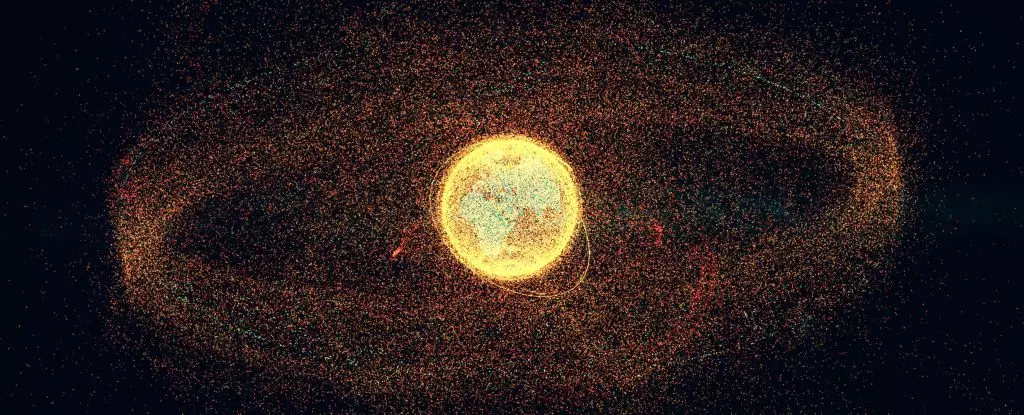The cosmos that surrounds our blue planet, while often romanticized and revered, is currently facing an existential threat: the ever-increasing volume of space debris. According to the European Space Agency (ESA), the amount of man-made junk orbiting Earth is proliferating at an alarming pace. Every year, the number of satellites launched into space far outweighs those diligently decommissioned and safely returned to the atmosphere. This burgeoning debris field isn’t merely an eyesore; it poses a monumental risk to both operational satellites and the future of space exploration itself.
Foremost among the concerns is the impending reality of the Kessler Syndrome. This phenomenon articulates a dire scenario in which collisions between space objects lead to a cascading effect, generating even more debris that can perilously encapsulate specific orbits. The underlying scientific consensus is grim: even if no new satellites are launched, the stockpile of space junk will continue to escalate due to existing fragmentation events. These collisions and explosive failures create a feedback loop that intensifies the risk of catastrophic incidents in our orbital domain.
The Numbers Don’t Lie
To comprehend the gravity of the situation, it’s striking to consider the numbers. The ESA currently monitors over 40,000 objects in Earth’s orbit, of which approximately 11,000 are functional satellites. However, that figure glosses over the colossal amount of junk in the upper atmosphere, resulting in a staggering estimate of around 54,000 pieces larger than 10 centimeters in diameter and an additional 1.2 million fragments ranging from 1 to 10 centimeters. The horror intensifies when examining the smallest pieces, with around 130 million particles, measuring between 1 millimeter and 1 centimeter, swirling at terrifying velocities.
While it might be easy to shrug off some of this debris as harmless, even the tiniest fragments possess the potential to inflict catastrophic damage on operational vehicles soaring through the sky. The International Space Station and the Hubble Space Telescope, both crucial to scientific discovery, find their operations at risk from this unrelenting barrage of detritus. The sheer randomness and unpredictability of space junk, combined with natural wear and explosive events, further complicate the already precarious situation.
More Than Just Collisions
Interestingly, the threat isn’t solely confined to collisions. In 2024, non-collisional fragmentation emerged as the predominant source of space debris, epitomizing the uncontrolled nature of the situation. With 11 recorded fragmentation events generating over 2,600 new debris pieces, it becomes clear that the problem isn’t just about existing materials colliding; the very nature of our technology creates an ongoing churn of new detritus.
As it stands, the random encounters with this debris not only threaten hardware but fundamentally challenge the entire concept of space as a safe operating zone. Without a proactive means of managing these risks, the future of both governmental and private space exploration looks increasingly tenuous.
Small Wins and Future Strategies
Despite these overwhelming challenges, glimmers of hope are emerging. The trend toward controlled decommissioning of satellites and rocket stages has demonstrated marked improvements. The ESA reported that in 2024, a higher percentage of rocket bodies were successfully either safely disposed of or re-entered Earth’s atmosphere within stringent timeframes. Approximately 90% of objects in low-Earth orbit were vacated in compliance with mandated standards, and the prospect of controlled re-entries has, for the first time, garnered a modicum of success.
Yet prohibiting new debris is only half the battle. The real challenge lies in the active cleanup of our orbital lanes. This complex endeavor will necessitate global cooperation and innovative technologies aimed at capturing and recycling the past remnants of our space endeavors. It demands not just investment and resource allocation but a dedicated commitment to paving a brighter path forward, ensuring that the infinite expanse above us doesn’t become a perilous no-man’s-land.
The Path Forward: A Collaborative Solution
The escalating debris crisis in Earth orbit is not merely a concern for scientists or space agencies; it impacts humanity’s prospects in exploration and technology development. As we gaze toward the stars, we must foster a mindset of custodianship for our orbital environment. Achieving this will require international collaboration, involving stakeholders at every level, from government entities to private aerospace companies.
We stand on the precipice of a transformative time in space policy and technology. The need to embrace innovative methods for debris reduction and cleanup is paramount. If humanity can unite to confront this challenge, we could redefine our relationship with space, heralding a new era of exploration and sustainability that respects the delicate balance of our cosmos. The future depends on whether we rise to meet this critical juncture with ingenuity and resolve.


Leave a Reply